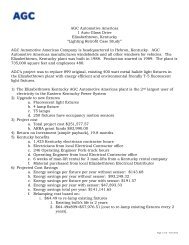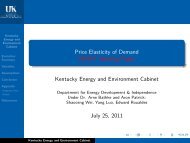Kentucky Coal Facts - 13th Edition - Department for Energy ...
Kentucky Coal Facts - 13th Edition - Department for Energy ...
Kentucky Coal Facts - 13th Edition - Department for Energy ...
Create successful ePaper yourself
Turn your PDF publications into a flip-book with our unique Google optimized e-Paper software.
<strong>Coal</strong> Formation & Properties<br />
Formation of <strong>Coal</strong><br />
<strong>Coal</strong> <strong>for</strong>ms from peat that is buried and subsequently altered by a combination of time, pressure and heat. This metamorphic<br />
process is termed coalification. Peat is <strong>for</strong>med and preserved in mires, a collective term that includes all peat<strong>for</strong>ming<br />
ecosystems. Bogs, swamps, and marshes are all specific types of mires. All of the economically-important coal<br />
beds in <strong>Kentucky</strong> are Pennsylvanian in age, <strong>for</strong>ming between 280 to 320 million years ago.<br />
<strong>Coal</strong> Rank and Grade<br />
<strong>Coal</strong> is generally classified in terms of Rank and Grade. Rank refers to the level of metamorphism, or alteration, the<br />
organic material in the original peat was subjected to after burial. As rank increases, moisture and volatile matter content<br />
decrease — fixed carbon content and calorific value increase. Very low rank coal is called lignite. Higher rank<br />
coals are classified as either sub-bituminous, bituminous, or anthracite, depending on their calorific value and (in higher<br />
rank coal) fixed carbon and volatile matter contents. All of the mineable coal in <strong>Kentucky</strong> is bituminous in rank. Grade<br />
refers to the amount and type of impurities in coal, specifically ash and sulfur. Most of the coal mined in <strong>Kentucky</strong> contains<br />

















